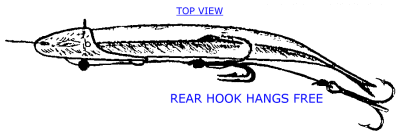 |
| BAIT
ACTION
Fisherman have used small fish for bait for as long as they have known big fish eat little fish. The Pacific coastal Native Indians rigged baitfish such as herring on bone-barbed hooks and caught any amount of salmon, cod, and halibut. Pioneers on coming to the coast copied and refined the Native's techniques, so that by trolling herring behind a dug-out canoe or row boat (on a basic handline, with a sinker) they could easily catch one's winter supply of salmon. In the 30's rod and reel anglers caught salmon by using baits rigged behind a herring dodger, an 8" to 10" flat shinny metal plate which swayed or wobbled when trolled throught the water. the swaying motion of the herring dodger caused the bait to to sway or dart, resembling a wounded (Krippled) baitfish, an action which enticed salmon to strike. In the 40's herring minnows were processed in saltbrine and packed in small glass jars, specifically for sport anglers. By the early 50's fresh frozen herring were available for bait. these baits were netted and packaged specifically to fit into the first plastic bait holder heads, designed to facilitate the rigging of baits for salmon anglers. Sports fishermen for the first time could now combine the simplicity of an artificial lure with the effectiveness of live bait. Rigging the bait is simple but controlling its action is another skill which requires some basic understanding. Possibly the most common misconception held by neophyte salmon anglers is the fact that they feel one is successfully fishing if he has bait on the end of his line. What he doesn't understand is the bait must have action. The most productive bait action for salmon, whether it be herring minnow, herring, herring strip, anchovy, or sandlance, is a spiral roll. Actively feeding chinook salmon in coastal waters where the tidal current is strong (3-6 knots) usually prefer a bait with a roll which is classed as fairly fast (faster than one revolution per second). These same chinook salmon after moving into inside waters (bays and inlets) with little tidal current, prefer a bait with a slower spiral roll. Feeding coho salmon usually prefer a smaller bait with a snappy, loopy roll. The spiral roll can be controlled somewhat by varying your troll speed - the faster the troll, the faster the bait revolutions, the slower the troll speed the slower the revolutions. The curvature of a rigged bait will determine the speed of the revolution and the type of spiral roll. A 'banana' shaped curve in your bait will impart a corkscrew fast roll. A slight curve in only the tail portion of a straight bait will often result in a tight slow roll rate.
When fishing any bait spend some time rigging and observing the bait's action in the water before letting it out. Be prepared to make slight adjustments in your troll speed, hook position, placement, and the actual curve in your bait. Time spent in making bait action changes are often very productive and worthwhile. Salmon are not intelligent or smart, but can be very fussy feeders, particularly if there are large amounts of natural baitfish in the area. Salmon do not feed constantly, they appear to have activity or 'bite' periods. Salmon will gorge themselves in these short bite periods and may not feed again for several hours or even days. At such times your bait must be rigged and presented to appear as a wounded (Krippled) baitfish, an irresistible easy prey for some stuffed salmon, who just can't resist that one last bite. Learn to observe the slight differences in the bait's action and be able to duplicate this when the bite is on. Fine tuning bait action is one of the main reasons 90% of the salmon are caught by 10% of the anglers. |
| [TOP] |
|
Home | Products | Where to Find | Fishing Tips
| About Us | Email Us Copyright © 1998 - 2004 |
